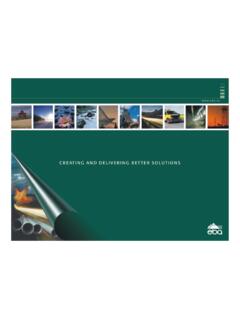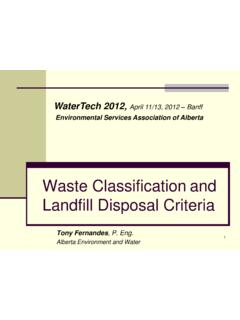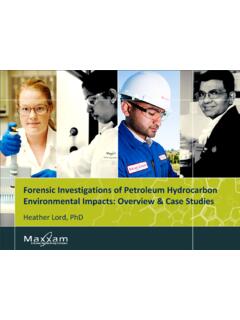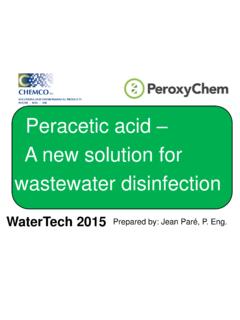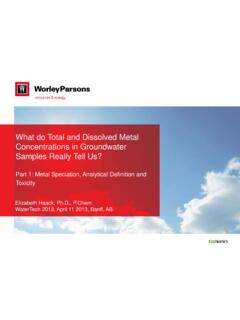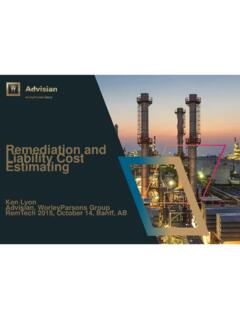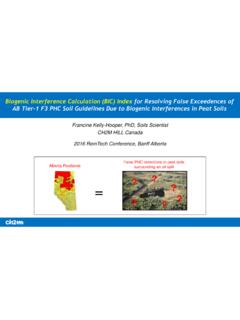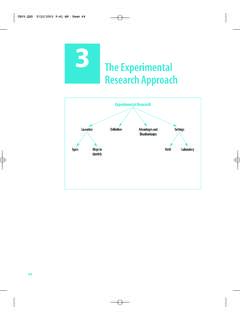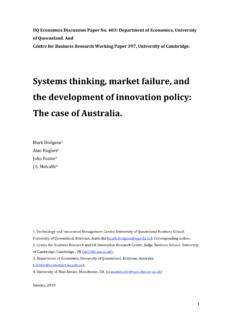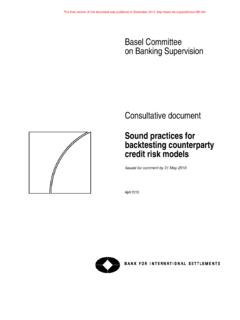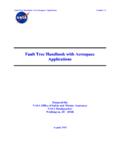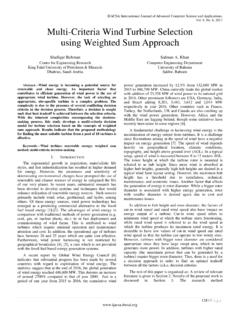Transcription of The Environment Agency’s probabilistic groundwater risk ...
1 The Environment Agency s probabilistic groundwater risk assessment software: a UK perspective on assessing the risks posed by leaching contaminants Stephen Barnes and David Hall Presentation Structure Overview Software Packages Performance Criteria Operation Conceptual Model Inputs Why probabilistic ? Output Capability Summary Options Comparison with CCME Tier 2 equations Summary of Application October 21, 2014 2 Overview Software Packages October 21, 2014 3 Quantitative assessment of the impact of contaminated land on groundwater .
2 First released in 1999 now Quantitative assessment of the impact of landfilling on groundwater . First released in 1996 now Output validated during development against measured site data from a range of groundwater environments; and since verified by multiple site assessments and users Help in decision making, is there a significant risk to a Domestic Use Aquifer, which of the contaminants should I be worried about? Overview Performance Criteria October 21, 2014 4 Predict the fate and transport of contaminants from source concentrations, through the unsaturated zone and within the aquifer/ groundwater system Calculate travel times and concentrations likelihood of exceeding Water Quality Guidelines Multi-tier assessment approach Can be used as screening tools or as more detailed risk assessment tools depending upon data availability Aid in risk estimation (not risk characterization)
3 October 21, 2014 5 BACKGROUND BACKGROUND CONSTANT OR DECLINING SOURCE UNDERFLOW INCLUDING BACKGROUND CONCENTRATION RECEPTOR DIRECTLY DOWN GRADIENT OR LATERALLY OFFSET ADVECTION DISPERSION RETARDATION BIODEGRADATION/DECAY DILUTION LEAKAGE MASS BALANCE Operation Conceptual Model Leachate head? Drainage system? Liner? October 21, 2014 6 October 21, 2014 6 6 Slide 2 Operation Conceptual Model BACKGROUND BACKGROUND UNDERFLOW INCLUDING BACKGROUND CONCENTRATION OR LATERALLY OFFSET ADVECTION DISPERSION RETARDATION BIODEGRADATION/DECAY DILUTION RECEPTOR DIRECTLY DOWN GRADIENT CONSTANT , DECLINING SOURCE, OR USER SPECIFIED LEACHING MASS BALANCE Soil concentrations or pore water quality October 21, 2014 7 Operation Inputs (1) Site specific and/or referenced inputs covering range of values characterizing.
4 Infiltration through various phases of landfill life-cycle, to soil surface, or as soakaway/infiltration ditch Source term Contaminated soil/waste thickness Bulk density Initial soil concentrations (mg/kg) or leachate concentrations (mg/L) Unsaturated zone Thickness/length Moisture content Hydraulic conductivity October 21, 2014 8 Operation Inputs (2) Aquifer Pathway length Width perpendicular to flow Mixing zone thickness Hydraulic conductivity and gradient Porosity Dispersivity Background concentration range Contaminant transport characterization Partition coefficients Fraction of organic carbon Half lives October 21, 2014 9 Operation Why probabilistic ?
5 (1) Uncertainty in the inputs and outputs Which input values do we choose? Mean, mode, median, 50th percentile, 95th percentile, single site value, single literature value etc. Accounts for parameter uncertainty Because it s there (spatial variability, measurement error etc.) Makes a real difference to the results Should be an unbiased methodology Helps in decision making October 21, 2014 10 Operation Why probabilistic ? (2) Characterize inputs as Probability Density Functions Monte Carlo Analysis used for sampling PDFs October 21, 2014 11 Hydraulics includes predictions of.
6 Leachate head and leakage rates for large variety of liner types (incorporating liner degradation through time as applicable) Flow to the leachate treatment plant Dilution factors Surface breakout Flow volumes in the aquifer Times to peak concentrations at the groundwater table and in the aquifer Output Capability Summary (1) October 21, 2014 12 Contaminant concentrations includes predictions of: Source Base of liner (if present) Base of the unsaturated zone Base of vertical pathway (if present) In aquifer at the edge of the landfill (impact of individual cell) or a down gradient receptor (cumulative impact) Output Capability Summary (2) October 21, 2014 13 Output Options (1) Results: New development, Leakage From EBS [l/day]Time His tory07/10/2014 18:40:29C.
7 \Barnes\RemTech\New Development Percentile10th Percentile50th Percentile90th Percentile95th PercentileTime [years]6,0005,5005,0004,5004,0003,5003,0 002,5002,0001,5001,0005000 Leakage From EBS [l/day]9,0008,0007,0006,0005,0004,0003,0 002,0001,0000 Results: New development, Flow to Leachate Treatment Plant [l/day]Time His tory07/10/2014 18:40:29C:\Barnes\RemTech\New Development Percentile10th Percentile50th Percentile90th Percentile95th PercentileTime [years]6,0005,5005,0004,5004,0003,5003,0 002,5002,0001,5001,0005000 Flow to Leachate Treatment Plant [l/day] + +00 Results: New development, DilutionTime His tory07/10/2014 18:40:29C.
8 \Barnes\RemTech\New Development Percentile10th Percentile50th Percentile90th Percentile95th PercentileTime [years]6,0005,5005,0004,5004,0003,5003,0 002,5002,0001,5001,0005000 Dilution20,00015,00010,0005,0000 Project Information matching results Justification for individual parameters October 21, 2014 14 Source Source Pathway Source Pathway Receptor Level 1 deals with the source only limited site investigation, limited cost highly conservative Level 2 deals with the Unsaturated zone more intensive SI higher cost less conservative Level 3 deals with the aquifer full hydrogeological study needed least conservative Level 3a does not fit into this structure and is included to allow increased functionality only Output Capability Summary (3) October 21, 2014 15 Output Options (2) October 21, 2014 16 Comparison with CCME Tier 2 Equations (1) Similarities include: Conceptual model.
9 Initial partitioning between soil and groundwater concentrations in source; Immiscible phase contaminant not considered; Unsaturated zone plug flow driven by infiltration rate and moisture displacement; Output options for concentrations just above the groundwater table and downstream in the aquifer; Mixing of leachate and groundwater assumed to occur through mixing of mass fluxes; and Consideration of dispersion, retardation and degradation. October 21, 2014 17 Comparison with CCME Tier 2 Equations (2) Differences are that LandSim/ConSim include.
10 Range of input values and a probabilistic analysis Impact assessments that do not specifically back calculate remedial targets Source term degradation Cumulative impact from various cells or areas of concern A confined aquifer option (vertical pathway) Vertical dispersivity input is possible to constrain mixing zone thickness in aquifer Option to include up gradient or background groundwater quality data characterization Sensitivity analysis output option (ConSim only) Time series data can be exported to EXCEL Summary of Application Output helps communicate the real risks Helps direct effort regarding site investigation Helps in the decision making process around the containment of contaminated water and/or in the management of contaminated land Helps demonstrate compliance through prior investigation Typically 95th percentile concentrations used for regulation purposes 50th percentile (most likely)
